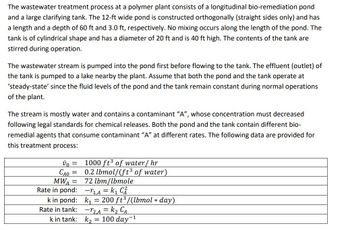thank you, last question Regulations of Contaminant (A) call for PPM ≤ 20 PPM Is the treatment in spec? Calculate the final concentration in units of PPM.
thank you, last question
Regulations of Contaminant (A) call for PPM ≤ 20 PPM Is the treatment in spec? Calculate the final concentration in units of PPM.
The regulations of contaminant A call for a PPM of 20 or less. The initial concentration of contaminant A is 100 PPM and the treatment rate is 0.5 PPM/ day.
The final concentration of contaminant A can be calculated using the following formula:
Plugging in the values, we get:
Therefore, the final concentration of contaminant A is 50 PPM. This is within a PPM of 20 or less, so the treatment is in spec.
Step by step
Solved in 4 steps with 2 images

im sorry i dont understand, can you please re-do in a different way maybe showing units
Regulations of Contaminant (A) call for PPM less than or = to 20 PPM. is the treatment in spec? Calculate the final concentration in units of PPM.









